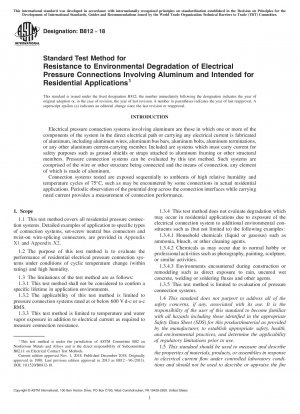ASTM B812-18
Standard Test Method for Resistance to Environmental Degradation of Electrical Pressure Connections Involving Aluminum and Intended for Residential Applications
- Standard No.
- ASTM B812-18
- Release Date
- 2018
- Published By
- American Society for Testing and Materials (ASTM)
- Latest
- ASTM B812-18
- Scope
- 1.1 This test method covers all residential pressure connection systems. Detailed examples of application to specific types of connection systems, set-screw neutral bus connectors and twist-on wire-splicing connectors, are provided in Appendix X1 and Appendix X2. 1.2 The purpose of this test method is to evaluate the performance of residential electrical pressure connection systems under conditions of cyclic temperature change (within rating) and high humidity. 1.3 The limitations of the test method are as follows: 1.3.1 This test method shall not be considered to confirm a specific lifetime in application environments. 1.3.2 The applicability of this test method is limited to pressure connection systems rated at or below 600 V d-c or a-c RMS. 1.3.3 This test method is limited to temperature and water vapor exposure in addition to electrical current as required to measure connection resistance. 1.3.4 This test method does not evaluate degradation which may occur in residential applications due to exposure of the electrical connection system to additional environmental constituents such as (but not limited to) the following examples: 1.3.4.1 Household chemicals (liquid or gaseous) such as ammonia, bleach, or other cleaning agents. 1.3.4.2 Chemicals as may occur due to normal hobby or professional activities such as photography, painting, sculpture, or similar activities. 1.3.4.3 Environments encountered during construction or remodeling such as direct exposure to rain, uncured wet concrete, welding or soldering fluxes and other agents. 1.3.5 This test method is limited to evaluation of pressure connection systems. 1.4 This standard does not purport to address all of the safety concerns, if any, associated with its use. It is the responsibility of the user of this standard to become familiar with all hazards including those identified in the appropriate Safety Data Sheet (SDS) for this product/material as provided by the manufacturer, to establish appropriate safety, health, and environmental practices, and determine the applicability of regulatory limitations prior to use. 1.5 This standard should be used to measure and describe the properties of materials, products, or assemblies in response to electrical current flow under controlled laboratory conditions and should not be used to describe or appraise the fire 1 This test method is under the jurisdiction of ASTM Committee B02 on Nonferrous Metals and Alloys and is the direct responsibility of Subcommittee B02.11 on Electrical Contact Test Methods. Current edition approved Nov. 1, 2018. Published December 2018. Originally approved in 1990. Last previous edition approved in 2013 as B812 – 96 (2013). DOI: 10.1520/B0812-18. Copyright © ASTM International, 100 Barr Harbor Drive, PO Box C700, West Conshohocken, PA 19428-2959. United States This international standard was developed in accordance with internationally recognized principles on standardization established in the Decision on Principles for the Development of International Standards, Guides and Recommendations issued by the World Trade Organization Technical Barriers to Trade (TBT) Committee. 1 hazard or fire risk of materials, products, or assemblies under actual installation conditions or under actual fire conditions. However, results of this test may be used as elements of a fire risk assessment which takes into account all of the factors which are pertinent to an assessment of the fire hazard of a particular end use. 1.6 This international standard was developed in accordance with internationally recognized principles on standardization established in the Decision on Principles for the Development of International Standards, Guides and Recommendations issued by the World Trade Organization Technical Barriers to Trade (TBT) Committee.
ASTM B812-18 Referenced Document
- ANSI/NFPA 70 National Electrical Coder
- ASTM B542 Standard Terminology Relating to Electrical Contacts and Their Use*, 2019-11-01 Update
ASTM B812-18 history
- 2018 ASTM B812-18 Standard Test Method for Resistance to Environmental Degradation of Electrical Pressure Connections Involving Aluminum and Intended for Residential Applications
- 1996 ASTM B812-96(2013) Standard Test Method for Resistance to Environmental Degradation of Electrical Pressure Connections Involving Aluminum and Intended for Residential Applications
- 1996 ASTM B812-96(2008) Standard Test Method for Resistance to Environmental Degradation of Electrical Pressure Connections Involving Aluminum and Intended for Residential Applications
- 1996 ASTM B812-96(2002)e1 Standard Test Method for Resistance to Environmental Degradation of Electrical Pressure Connections Involving Aluminum and Intended for Residential Applications
- 1996 ASTM B812-96 Standard Test Method for Resistance to Environmental Degradation of Electrical Pressure Connections Involving Aluminum and Intended for Residential Applications
